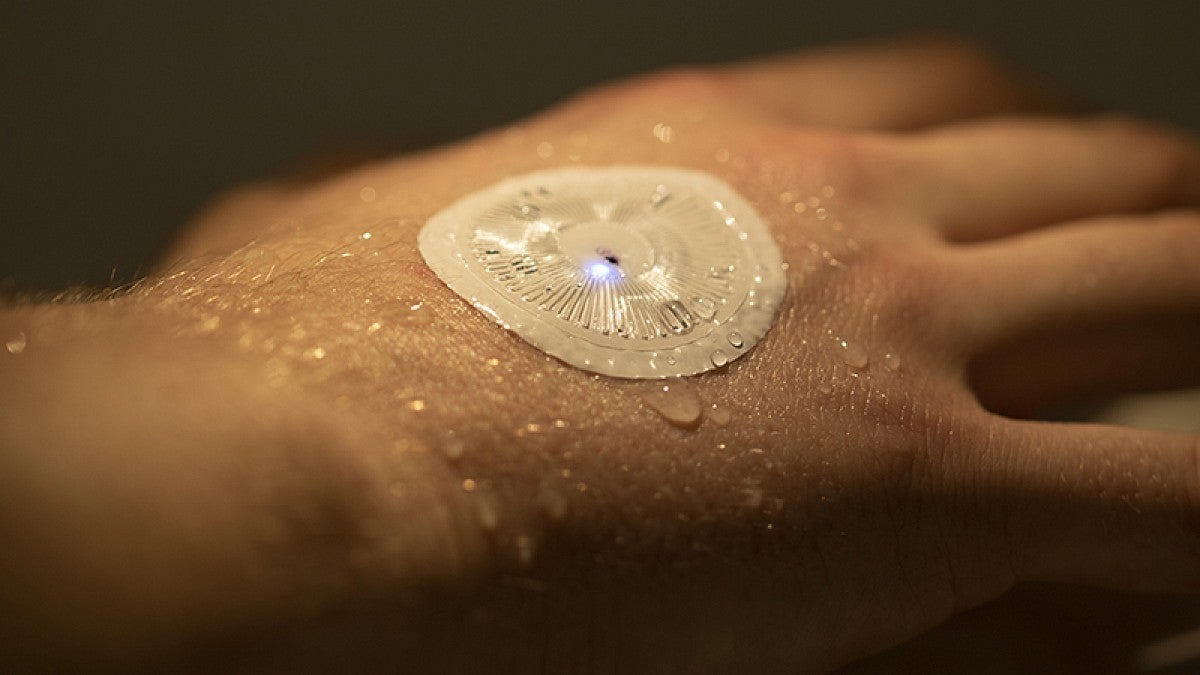Newly published research co-led by Jonathan Reeder, a new member of the Phil and Penny Knight Campus for Accelerating Scientific Impact, provides a preview of health monitoring devices and tools for fundamental brain research he is now pursuing at the UO.
In a new paper, completed during his postdoctoral work at Northwestern University, his team detailed advances in a soft, bandage-like patch lined with tiny channels and electronic sensors that collect and analyze sweat for health monitoring purposes. The paper published online Oct. 26 in Proceedings of the National Academy of Sciences.
In his new lab, work will continue on advancing the type of soft, biointegrated devices that was detailed in the paper, said Reeder, who joined the UO in September. He also has his sights set on an implant to mute pain following surgical repairs.
“Our recent work establishes methods for measuring important biomarkers in sweat, including cortisol, vitamin C and glucose, which provide measures of physical and mental stress,” said Reeder, whose specialty is polymer synthesis. “The ability to access this information noninvasively and in real time opens up new opportunities for continuous health monitoring across wide populations including athletes, military personnel and in clinical medicine.”
This work builds on devices in the field of epidermal microfluidics that emerged in 2016 from the lab of physical chemist John A. Rogers at the University of Illinois at Urbana-Champaign. Reeder, at that time, was completing doctoral work as a National Science Foundation fellow at the University of Texas at Dallas, where he developed soft, shape-programmable polymers and flexible electronic systems for neural modulation and electronic skins.
While at UT-Dallas, Reeder was a founder and research director of Pascalor Inc., a company focused on commercializing flexible electronic technologies. He joined Rogers’ group in 2017, after Rogers moved to Northwestern University. The new paper was a collaboration of researchers at the two Illinois institutions.
To date the research has focused on developing materials systems, in this case a system using rigid polyurethane microchannels embedded in soft silicone rubber, for bandage-like patches that can collect and route small volumes of sweat directly on the surface of the skin.
A challenge has been how to prevent loss of collected sweat caused by natural body movements or evaporation. The onboard sensors and wireless communication capabilities, he said, allow for data collection and transmission in real time.
In the study, the device was tested with subjects riding exercise bikes. Previous studies with earlier versions had participants working out on treadmills and in open-ocean swimming to measure the ability to measure sweat rates and loss, as well as changes in skin temperatures during vigorous physical activity.
Rogers, by way of his startup company Epicore Biosystems, currently is testing similar devices in a collaboration with Gatorade and its parent company PepsiCo Inc. That work could soon lead to a wearable patch for athletes to monitor their hydration.
Reeder, an assistant professor at the Knight Campus and an affiliate of the Department of Chemistry and Biochemistry, will head in somewhat different directions.
“One of my lab’s research directions will focus on further developing classes of soft, wearable systems for quantifying and improving human performance,” he said. “In particular, we’ll focus on expanding the use of these devices for athletes. We will also be developing new wearable sensor modalities to monitor not only the wearer but the local environment, for example providing real-time measures of local air quality.”
Additionally, he said, concepts of some of the newly developed materials systems will be incorporated into implantable devices, including one that would move small amounts of coolant through microchannels in implants near nerves to numb pain.
“Imagine a scenario where someone undergoes a surgery on a leg,” Reeder said. “They could have a device implanted around an affected nerve that could dull the pain with a cooling affect and without the use of opioids. With opioids, the whole body is affected. And similar to an oral medicine, these implantable coolers are made from water-soluble materials that the body can break down and reabsorb.”
The cooling technology, now in its infancy, also could eventually provide new tools for fundamental neuroscience research, he added.
“We are building neural blocking and recording arrays that will allow us to selectively turn off neural activity in one region while simultaneously recording activity in surrounding regions,” he said. “This type of tool would be useful to neuroscientists for understanding how the brain is wired.”
—By Jim Barlow, University Communications


